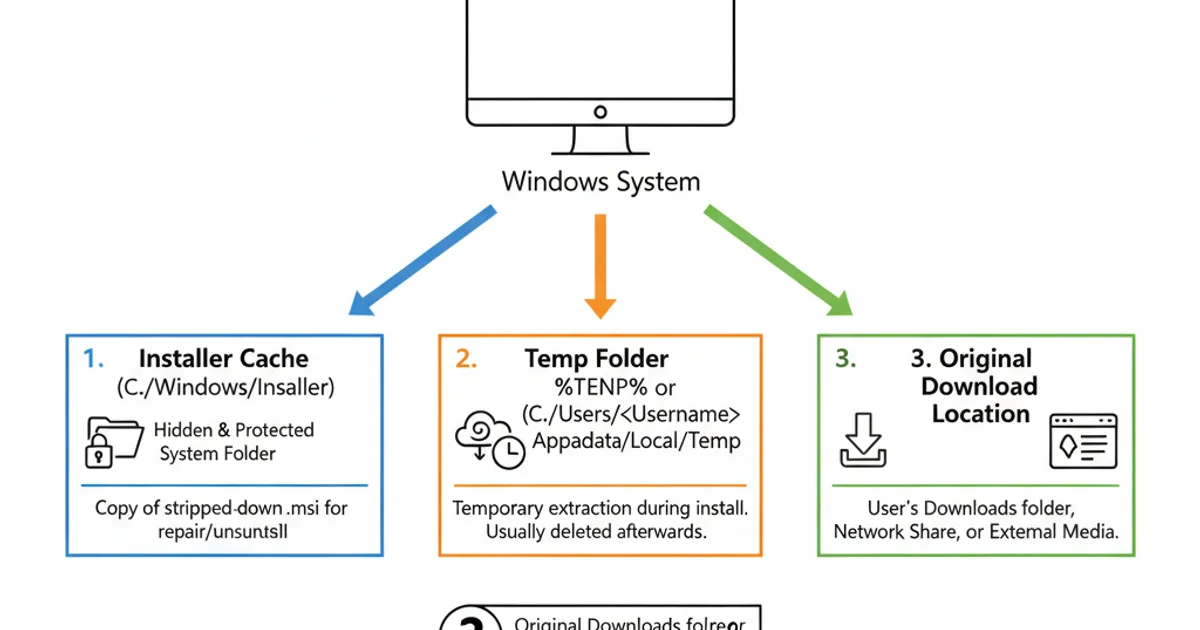Where the MSI file is copied after the installation?
Categories:
Understanding MSI File Locations After Windows Installation

Explore where Windows Installer (MSI) files are typically stored post-installation, why they are needed, and how to locate them for maintenance or uninstallation.
When you install software on Windows using an MSI (Microsoft Installer) package, the installation process often involves copying the original MSI file to a specific location on your system. This isn't just for archival purposes; the cached MSI file plays a crucial role in future operations like repairing, modifying, or uninstalling the software. Understanding where these files reside can be vital for troubleshooting and system administration.
The Windows Installer Cache
The primary location for cached MSI files is the Windows Installer cache. This is a protected system folder where Windows stores a copy of every MSI and MSP (Microsoft Installer Patch) file used to install or update software. The purpose of this cache is to ensure that the necessary installation source is always available for repair, modification, or uninstallation operations, even if the original installation media is no longer present.
C:\Windows\Installer). Doing so can lead to severe issues when trying to repair, update, or uninstall software, potentially requiring a full system restore or manual registry cleanup.The path to this cache is usually C:\Windows\Installer. This folder is hidden and protected by system permissions, preventing accidental deletion. Each cached file is renamed to a GUID (Globally Unique Identifier) with an .msi or .msp extension, making it difficult to identify which file belongs to which application without additional tools or registry lookups.
flowchart TD
A[User Installs Software] --> B{MSI Package Executed}
B --> C[Windows Installer Service Activated]
C --> D["Original MSI Copied to C:\\Windows\\Installer"]
D --> E[Software Files Installed to Program Files]
E --> F[Registry Entries Created]
F --> G[Installation Complete]Typical MSI Installation Flow and Cache Creation
Locating Specific MSI Files in the Cache
While the C:\Windows\Installer folder contains all cached MSI files, finding the specific one for a particular application can be challenging due to the GUID-based filenames. You can use the Windows Registry to map installed applications to their cached MSI files. Each installed application typically has an entry under HKEY_LOCAL_MACHINE\SOFTWARE\Microsoft\Windows\CurrentVersion\Installer\UserData\S-1-5-18\Products (for 64-bit systems, also check HKEY_LOCAL_MACHINE\SOFTWARE\WOW6432Node\Microsoft\Windows\CurrentVersion\Installer\UserData\S-1-5-18\Products).
Within these product GUIDs, you'll often find a InstallProperties key or similar, which contains a LocalPackage value pointing to the full path of the cached MSI file (e.g., C:\Windows\Installer\{GUID}.msi).
$productName = "Your Application Name"
$msiPath = Get-ItemProperty HKLM:\SOFTWARE\Microsoft\Windows\CurrentVersion\Uninstall\* | Where-Object { $_.DisplayName -like "*$productName*" } | Select-Object -ExpandProperty InstallLocation
if ($msiPath) {
Write-Host "MSI for '$productName' might be in: $msiPath"
} else {
Write-Host "Could not find installation path for '$productName'. Checking Installer cache..."
# More complex logic needed to map DisplayName to cached MSI GUID
# This often involves iterating through HKLM:\SOFTWARE\Microsoft\Windows\CurrentVersion\Installer\UserData\S-1-5-18\Products
# and matching Product Name with cached MSI path.
}
PowerShell snippet to attempt locating an installed application's path (not directly the cached MSI).
Other Potential MSI Locations
While the Windows Installer cache is the primary location, some applications might behave differently or leave remnants elsewhere:
- Temporary Directories: During the initial execution, MSI files might be extracted to temporary directories (e.g.,
%TEMP%orC:\Users\<username>\AppData\Local\Temp). These are usually cleaned up after installation but can sometimes persist. - Application-Specific Folders: Very rarely, an application's installer might place a copy of its MSI within its own installation directory (e.g.,
C:\Program Files\YourApp\Installer). This is not standard practice for Windows Installer but can occur with custom installers. - Original Download Location: The most straightforward, though not always reliable, place to find the MSI is where you originally downloaded it. If you keep your downloads organized, this can be a quick way to retrieve the original package.

Various locations where MSI files might be found on a Windows system.